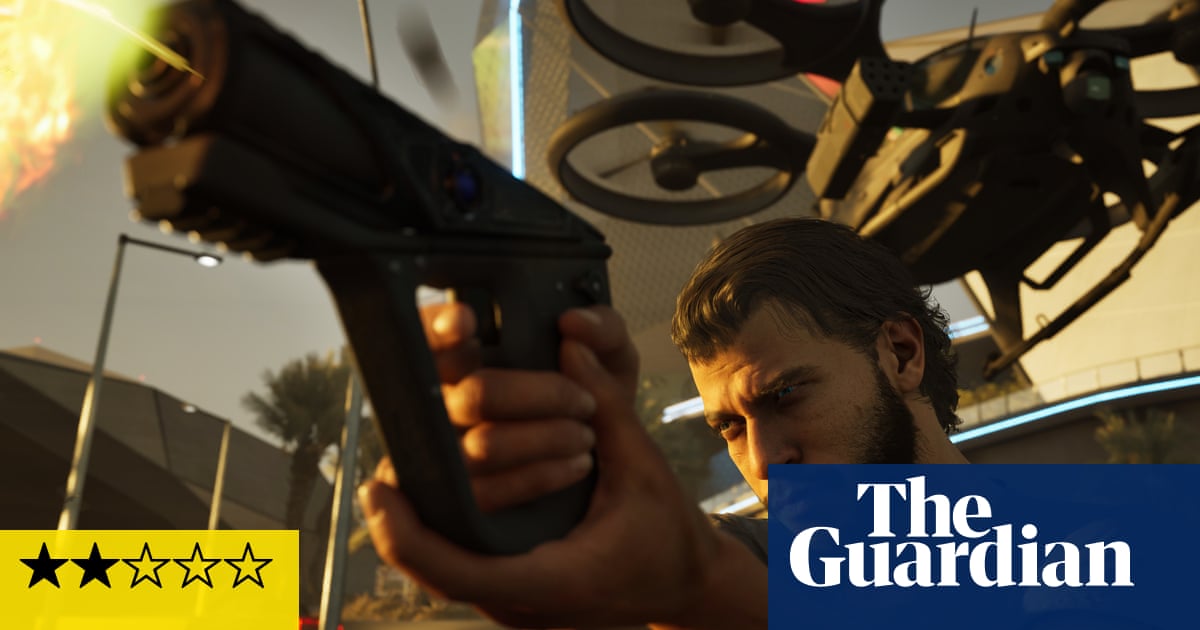There’s a Sphere-alike in Redrock, MindsEye’s open-world version of Las Vegas. It’s pretty much a straightcopy of the original: a huge soap bubble, half sunk into the desert floor, with its surface turned into a gigantic TV. Occasionally you’ll pull up near the Sphere while driving an electric vehicle made by Silva, the megacorp that controls this world. You’ll sometimes come to a stop just as an advert for an identical Silva EV plays out on the huge curved screen overhead. The doubling effect can be slightly vertigo-inducing.
At these moments, I truly get what MindsEye is trying to do. You’re stuck in the ultimate company town, where oligarchs and other crooks run everything, and there’s no hope of escaping the ecosystem they’ve built. MindsEye gets this all across through a chance encounter, and in a way that’s both light of touch and clever. The rest of the game tends towards the heavy-handed and silly, but it’s nice to glimpse a few instances where everything clicks.
With its Spheres and omnipresent EVs, MindsEye looks and sounds like the future. It’s concerned with AI and tech bros and the insidious creep of a corporate dystopia. You play as an amnesiac former-soldier who must work out the precise damage that technology has done to his humanity, while shooting people and robots and drones. And alongside the campaign itself, MindsEye also has a suite of tools for making your own game or levels and publishing them for fellow players. All of this has come from a studio founded by Leslie Benzies, whose production credits include the likes of GTA 5.
What’s weird, then, is that MindsEye generally plays like the past. Put a finger to the air and the wind is blowing from somewhere around 2012. At heart, this is a roughly hewn cover shooter with an open world that you only really experience when you’re driving between missions. Its topical concerns mainly exist to justify double-crosses and car chases and shootouts, and to explain why you head into battle with a personal drone that can open doors for you and stun nearby enemies.
It can be an uncanny experience, drifting back through the years to a time when many third-person games still featured unskippable cut-scenes and cover that could be awkward to unstick yourself from. I should add that there are plenty of reports at the moment of crashes and technical glitches and characters turning up without their faces in place. Playing on a relatively old PC, aside from one crash and a few amusing bugs, I’ve been mostly fine. I’ve just been playing a game that feels equally elderly.
This is sometimes less of a criticism than it sounds. There is a definite pleasure to be had in simple run-and-gun missions where you shoot very similar looking people over and over again and pick a path between waypoints. The shooting often feels good, and while it’s a bit of a swizz to have to drive to and from each mission, the cars have a nice fishtaily looseness to them that can, at times, invoke the Valium-tinged glory of the Driver games. (The airborne craft are less fun because they have less character.)
And for a game that has thought a lot about the point at which AI takes over, the in-game AI around me wasn’t in danger of taking over anything. When I handed over control of my car to the game while tailing an enemy, having been told I should try not to be spotted, the game made sure our bumpers kissed at every intersection. The streets of this particular open world are filled with amusingly unskilled AI drivers. I’d frequently arrive at traffic lights to be greeted by a recent pile-up, so delighted by the off-screen collisions that had scattered road cones and Dumpsters across my path that I almost always stopped to investigate.
I even enjoyed the plot’s hokeyness, which features lines such as: “Your DNA has been altered since we last met!” Has it, though? Even so, I became increasingly aware that clever people had spent a good chunk of their working lives making this game. I don’t think they intended to cast me as what is in essence a Deliveroo bullet courier for an off-brand Elon Musk. Or to drop me into an open world that feels thin not because it lacks mission icons and fishing mini-games, but because it’s devoid of convincing human detail.
I suspect the problem may actually be a thematically resonant one: a reckless kind of ambition. When I dropped into the level editor I found a tool that’s astonishingly rich and complex, but which also requires a lot of time and effort if you want to make anything really special in it. This is for the mega-fans, surely, the point-one percent. It must have taken serious time to build, and to do all that alongside a campaign (one that tries, at least, to vary things now and then with stealth, trailing and sniper sections) is the kind of endeavour that requires a real megacorp behind it.
MindsEye is an oddity. For all its failings, I rarely disliked playing it, and yet it’s also difficult to sincerely recommend. Its ideas, its moment-to-moment action and narrative are so thinly conceived that it barely exists. And yet: I’m kind of happy that it does.
